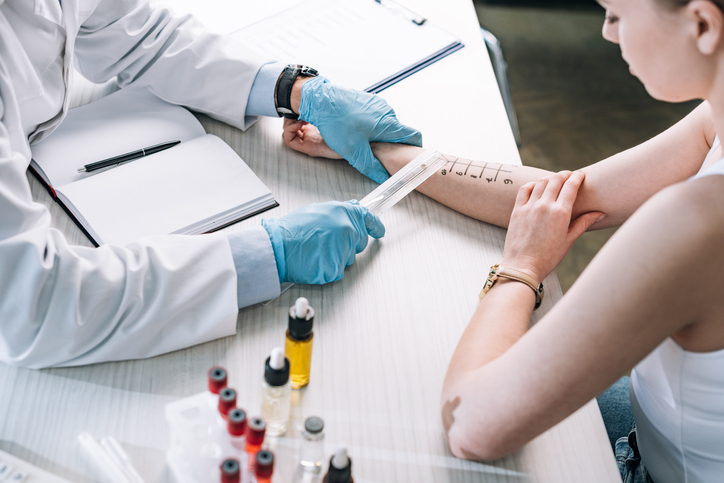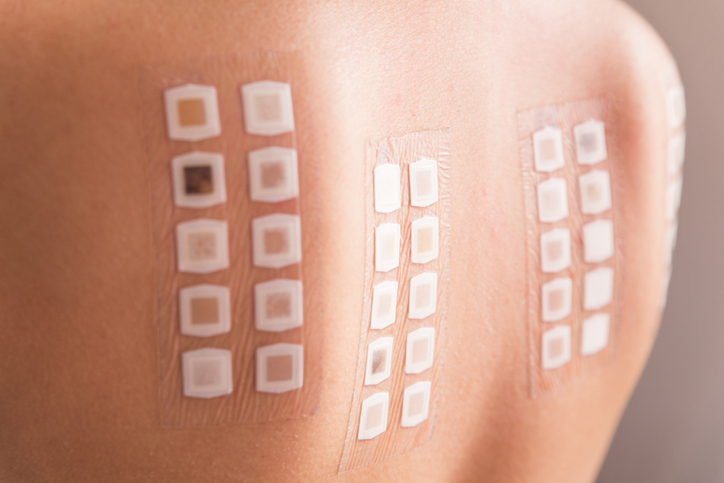Allergy testing is a procedure that identifies substances that can cause an allergic reaction. Allergy tests are widely used to diagnose allergies to specific foods, insect stings, pollen, and other allergens.
Join us at SANE MD for a comprehensive diagnostic testing blog post that looks at allergy testing as we explore its purposes, types of allergy tests, risks, and why it’s beneficial for allergy relief. If you want to learn more about diagnostic tests, check out our Laryngoscopy Purpose Guide!

- New Report Says Your Brain Could Be the Key to Reducing Phlegm Over 50
- Doctor's "Leave The Throat Phlegm Behind" Tutorial Goes Viral With People Over 50
- Can You Relieve Throat Phlegm and Coughing In 60 Seconds A Day? This Doctor Says Yes
- How To Banish Phlegm When 50+ (Do This Every Day)
Key Takeaways
- An allergic reaction occurs when an individual’s immune system mistakenly identifies a foreign substance — such as bee venom or pollen — as harmful and overreacts to protect them.
- Allergy testing helps identify the specific allergen that triggers an allergic reaction.
- If you’re experiencing allergic reactions, allergy testing can help determine the cause and develop an appropriate treatment plan.
Allergy Testing Overview
Allergies are a common problem affecting millions of people worldwide. When your immune system identifies a foreign substance as harmful, it produces antibodies to fight off the invader. In the case of allergies, the immune system produces antibodies that recognize a particular allergen as dangerous, despite the fact that it is harmless. When you encounter the allergen, your immune system’s reaction can lead to many unpleasant and even dangerous symptoms, such as a runny nose, nasal congestion, and trouble breathing.
The severity of allergies can vary from minor irritation to a life-threatening emergency called anaphylaxis. If you’re experiencing allergic reactions, allergy testing can help determine the cause. Although no cure for allergies exists, treatments are available to relieve symptoms.
Common Allergy Symptoms
Allergy symptoms vary depending on the allergen involved.
Hay Fever
Hay fever, also called allergic rhinitis, causes cold-like symptoms that may include:
- Runny nose
- Nasal congestion
- Sneezing
- Itchy nose or eyes
- Red, watery, or inflamed eyes

Food Allergies
Allergic reactions typically occur soon after consuming specific foods, with symptoms that affect your skin, airways, or digestive system. Food allergy symptoms can include:
- Hives (red, itchy skin rash)
- Swelling of the throat, tongue, lips, or face
- Mouth tingling
- Anaphylaxis (a severe allergic reaction that can be life-threatening)
Insect Sting Allergies
The symptoms of an insect sting allergy are many and can include:
- Redness around the injury
- Swelling in and around the sting area
- Hives
- Pain
- Itching
- Flushed skin, usually in the face, neck, or chest area
- Cough
- Chest tightness
- Anaphylactic shock (potentially life-threatening reaction characterized by wheezing, shortness of breath, and a significant drop in blood pressure)

Drug Allergies
A drug allergy can cause varied symptoms, including:
- Hives
- Wheezing
- Skin itch
- Skin rash
- Facial swelling
- Anaphylaxis
Atopic Dermatitis
Atopic dermatitis, or eczema, is an allergy that affects the skin, with symptoms that include:
- Itchy skin
- Skin rashes
- Peeling or flaking skin
- Reddened skin
Types of Allergy Testing
Various allergy testing methods exist, and your doctor will choose the most appropriate one depending on your symptoms and the likely allergens.
Below are the most common allergy tests.

Allergy Testing Skin Prick Tests
An allergy skin prick or scratch test allows your healthcare provider to check for immediate allergic reactions to up to 50 different substances simultaneously. This test typically identifies allergies to pollen, mold, pet dander, dust mites, and certain foods. The test is generally done on adults’ forearm and upper back for children.
The good news is that allergy skin tests are not painful. The procedure uses needles (lancets) that only slightly puncture the skin’s surface. There is no bleeding; you should only feel mild and momentary discomfort.
The nurse will first apply alcohol to the test site for sterilization purposes and then make small marks on your skin. After each mark, a drop of allergen extract will be applied. To avoid contamination, a new lancet is used for each allergen, and the extracts are pricked into the skin’s surface using the lancet. In addition, two other substances are scratched into your skin to assess its normal reaction.
- Histamine. It is crucial to be aware that histamine can trigger a skin reaction in most individuals. However, if you do not experience a histamine reaction, it is possible that an allergy skin test could miss detecting an allergy, even if you have one.
- Glycerin or saline. Conversely, glycerin or saline usually doesn’t cause any reaction in most people. But if you do experience a response to these substances, it could indicate that you have sensitive skin. Your healthcare provider must interpret test results carefully to avoid giving an incorrect allergy diagnosis.
After around 15 minutes of the skin pricks, the nurse will carefully observe your skin for any signs of allergic reactions. If you are allergic to any substances tested, you will develop a raised, red, itchy bump (wheal) that may resemble a mosquito bite. The nurse will then measure the size of the bump and record the results. Finally, the nurse will clean your skin with alcohol to remove any marks.

Allergy Testing Patch Tests
Patch testing is a type of medical examination that determines if a particular substance is responsible for causing allergic skin inflammation, known as contact dermatitis. Patch tests can identify delayed allergic reactions, which may take a few days to appear.
Unlike other medical tests, patch tests don’t involve needles. Instead, small amounts of allergens are applied to patches on your skin. During the patch test, your skin may be exposed to 20 to 30 substances that can cause contact dermatitis, such as latex, medications, fragrances, preservatives, hair dyes, metals, and resins.
The patches are worn on your arm or back for 48 hours. During this time, avoiding bathing and activities that cause heavy sweating is important. Once the 48 hours have passed, you will need to visit your doctor’s office to have the patches removed. If your skin shows any signs of irritation at the patch site, it may indicate an allergy.
Allergy Testing Skin Injection Tests
Your doctor may recommend a test that involves injecting a small amount of allergen extract into your skin using a needle (intradermal test). The injection site is observed for any allergic reaction after around 15 minutes. This test is usually recommended to check for penicillin or insect venom allergies.

Blood Tests
Blood tests (in vitro immunoglobulin E antibody tests) can be a helpful alternative for people who cannot or should not undergo skin tests. The procedure involves sending a blood sample to a lab, where allergens are added, and the levels of IgE antibodies are measured. However, it’s important to note that blood tests take longer to produce results and have a higher rate of false-positive outcomes.
Challenge Tests
This test should only be conducted under a healthcare provider’s direct, in-person supervision. Typically, an allergist, a physician specializing in allergies, will perform the test. Medical supervision is a must, as anaphylaxis may occur.
During the test, individuals with suspected food or drug allergies will swallow a small amount of the suspected allergen. If anaphylaxis occurs, the provider will administer an epinephrine injection to stop the reaction.
Medication Interference with Allergy Testing Results
It is important to inform your doctor of all the prescription and over-the-counter medications you are taking before scheduling a skin test. Certain medications can inhibit allergic reactions, leading to inaccurate results from the test. Conversely, some medications can increase the risk of severe allergic reactions during the test.
Medications that can interfere with allergy testing results include:
- OTC antihistamines, such as Claritin and Benadryl
- Prescription antihistamines, such as Vistaril
- Specific heartburn medications, such as Tagamet
- A specific asthma medication called omalizumab (Xolair)
Allergy Testing Risks
Awareness of the risks and potential complications involved in allergy skin testing is essential. Although rare, complications can become severe and even life-threatening. These complications may occur either during or after the test and can include the triggering of allergy symptoms, such as mild itching and skin swelling.
It’s important to note that a severe reaction, such as anaphylaxis or an asthma attack, can occur but is rare. However, your allergist is trained and prepared to treat an allergic reaction immediately.
Misreading the test results is also risky, leading to improper allergy treatment. This risk is much lower in the hands of a well-trained, skilled allergist.
Allergy Testing Results
Your doctor will tell you the results of a skin prick or intradermal test before you leave the office. There may be a delay in the results of a patch test for several days or longer.
Positive skin tests indicate that you are allergic to a particular substance. There is usually a greater degree of sensitivity shown by more prominent wheals. A negative skin test indicates that you are not allergic to a specific allergen.
It is important to remember that skin tests are not always accurate. In some cases, skin tests can indicate an allergy that doesn’t exist (false-positive) or show that you are allergic to something when there is none (false-negative). A test performed on different occasions may cause you to react differently. A substance may cause a positive reaction during a test while having an adverse reaction in everyday life.
Allergy Treatments
Depending on the type of allergy, your healthcare provider may recommend one or more of the following steps to manage it effectively:
• Avoid allergens: Minimize exposure to those that can cause severe reactions, such as specific foods or insect stings.
• Take OTC antihistamines daily: Antihistamines can prevent or reduce symptoms of allergic rhinitis and other allergies.
• Receive allergy shots: This immunotherapy can reduce the immune system’s response to specific allergens, such as pet dander. To experience maximum benefit, you should receive allergy shots for three to five years. Although allergy shots can be expensive, they often provide long-lasting relief, even after completing the shot series.
• Carry a medical alert card or wear alert jewelry. This will inform others of your severe allergy and let them know you could experience an anaphylactic response to allergens such as peanuts or bee stings.
• Carry an epinephrine injection (EpiPen): Keep this medicine with you at all times if you’re at risk of experiencing an anaphylactic allergic reaction.
Summary
Allergic reactions can vary from mild congestion to severe anaphylactic shock, which can be life-threatening. To identify the substances that cause allergic reactions of this kind, allergy tests are conducted. Different kinds of allergy tests are available, and the choice of test will depend on your symptoms and potential allergy triggers. If you suffer from allergies, you can take certain steps to alleviate your symptoms.
Frequently Asked Questions
How do they test for allergy?
Various allergy testing methods exist, and your doctor will choose the most appropriate one depending on your symptoms and the likely allergens.
The most common allergy tests include a skin prick test, where your doctor injects allergens into your skin to check for a raised mark called a wheal, rash, or other skin changes. Blood tests can check for IgE antibodies. Patch tests are used to diagnose contact dermatitis. Skin injection tests involve injecting a small amount of the allergen into the skin. Challenge tests are used to diagnose allergies to specific foods or drugs.
What is the most accurate allergy test?
Skin testing is typically the preferred method trained allergists use to diagnose allergies accurately. It is considered the most accurate test. In certain situations, blood tests may also be ordered. Choosing the right test is essential to aid in the diagnostic process and accurately determine the allergens causing the symptoms.
Do allergies get worse with age?
Our bodies undergo changes as we age, and so does our immune system. Just like we can no longer tolerate the cold, we may lose our ability to tolerate potential allergens, be it ragweed or dust mites. Conversely, research shows that we may develop immunity to the substances that formerly triggered allergic reactions.
What should you not do before an allergy test?
To prepare for an allergy test, it is essential to avoid certain medications that can affect the test results. Avoid taking over-the-counter antihistamines like Benadryl, cold and sinus medications, and sleep aids such as Tylenol PM for at least seven days before the test. Also, avoid medications like Tagamet, Pepcid, or Zantac one day before testing, as these contain a form of antihistamine. Additionally, do not take any tricyclic antidepressant medication before the test. These medications can interfere with the accuracy of the test results.

Dr. Matthew Olesiak, MD, is the Chief Medical Director at SANESolution, a renowned wellness technology company dedicated to providing evidence-based solutions for optimal living. Dr. Olesiak earned his medical degree from the prestigious Jagiellonian University Medical College in Kraków, Poland, where he developed a strong foundation in medicine.



